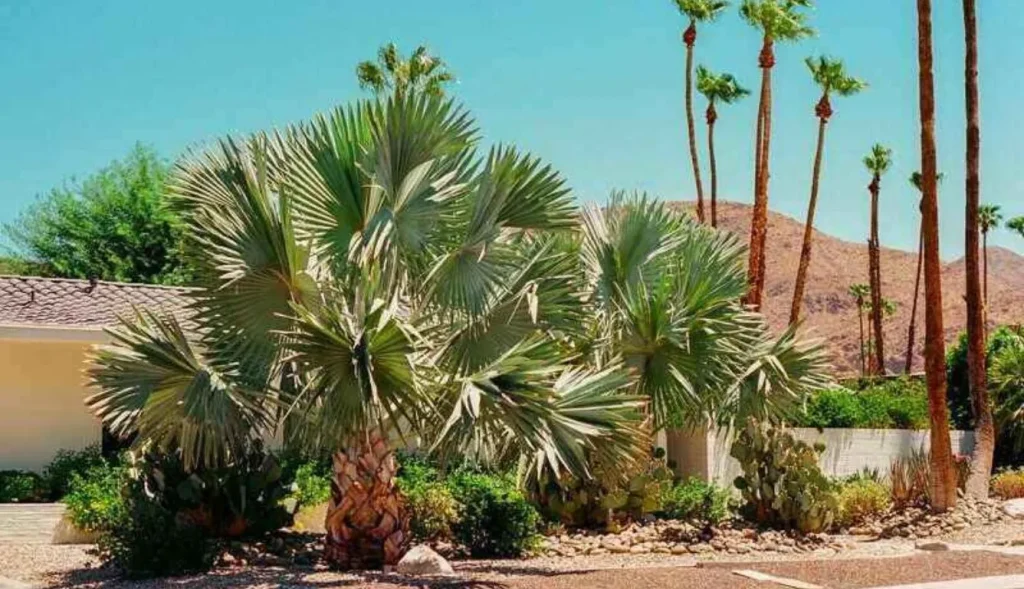Understanding Palm Tree Water Requirements
Different Types of Palm Trees
Palm trees are a diverse group of plants, and their water needs can vary significantly. Some common types include:
- Date Palms: These trees thrive in dry conditions but still need regular watering during their growth period.
- Coconut Palms: These require consistent moisture and should be watered more frequently.
- Areca Palms: Preferring slightly moist soil, these palms need a more controlled watering routine.
Watering Needs for Each Type
Understanding the specific needs of your palm tree type helps tailor your watering approach. For example, a Coconut Palm in a hot, dry climate will need more water than a Date Palm in a similar environment.

Factors Affecting Watering Frequency
Climate and Weather Conditions
The climate in which your palm tree is growing has a major impact on its water needs. In tropical climates with frequent rainfall, you might need to water less frequently. Conversely, in arid regions, you’ll need to water more often.
Soil Type
Soil type affects water retention. Sandy soils drain quickly, requiring more frequent watering. Clay soils, on the other hand, retain moisture longer but may need less frequent watering.
Size and Age of the Tree
Younger palm trees have shallower root systems and often need more frequent watering. As they mature and develop deeper roots, they become more drought-tolerant.
How to Water Palm Trees
Best Time to Water
The ideal time to water palm trees is early in the morning. This allows the water to soak in before the heat of the day causes evaporation.
Techniques for Effective Watering
When watering, ensure the water reaches the root zone. Use a slow, deep watering method to allow the roots to absorb moisture effectively. Avoid shallow watering, which can lead to shallow root systems.
Using Irrigation Systems
Drip irrigation systems are highly effective for palm trees, providing consistent moisture directly to the root zone without water waste. Sprinklers can be used but may require more frequent adjustments to avoid overwatering.
Signs of Overwatering and Underwatering
Identifying Overwatered Palm Trees
Overwatered palms may exhibit yellowing leaves, root rot, and a general decline in health. The soil will often be soggy, and there may be a musty smell.
Symptoms of Underwatered Palm Trees
Underwatered palms show signs like brown, dry leaves, and slow growth. The soil will be dry and may form a hard crust.
Seasonal Considerations
Watering in Different Seasons
Adjust your watering routine based on the season. During the winter, palm trees typically require less water due to cooler temperatures and reduced evaporation rates. In the summer, increase watering to match the higher evaporation rates.
Adjustments for Extreme Weather
During droughts or heavy rains, modify your watering practices accordingly. In drought conditions, increase the frequency and amount of water. After heavy rains, reduce watering to prevent waterlogging.
Common Mistakes to Avoid
Overwatering
One of the most common mistakes is overwatering, which can lead to root rot and other problems. Always check the soil moisture before watering.
Neglecting Soil Moisture
Ignoring the soil’s condition can lead to either overwatering or underwatering. Regularly check the moisture level to ensure your palm tree receives the right amount of water.
Tips for Palm Tree Care
Using Mulch and Fertilizer
Applying mulch around the base of the palm tree helps retain soil moisture and regulate temperature. Fertilizing helps support overall health but should be done according to the specific needs of the palm species.
Regular Monitoring
Keep an eye on your palm trees for any signs of stress. Regular monitoring allows you to adjust your care routine as needed.
FAQs
How often should I water my palm tree?
The frequency depends on the palm type, soil, and climate. Generally, check the soil moisture and water when it feels dry.
What is the best method for watering palm trees?
A slow, deep watering method is ideal, and using a drip irrigation system can be highly effective.
How can I tell if my palm tree is getting too much water?
Signs include yellowing leaves, root rot, and soggy soil. Adjust your watering practices accordingly.
What type of soil is best for palm trees?
Well-draining soil is ideal. Sandy soils are good for palms, but they may need more frequent watering.
Can I use a sprinkler system for my palm trees?
Yes, but ensure it’s set to provide deep, infrequent watering rather than shallow, frequent watering.

Conclusion
Proper watering is crucial for the health and longevity of palm trees. By understanding the specific needs of your palm type, adjusting for climate and soil conditions, and avoiding common mistakes, you can ensure your palm trees remain vibrant and healthy. Regular monitoring and adjustments based on seasonal changes will help you provide the best care possible.


Congratulation!